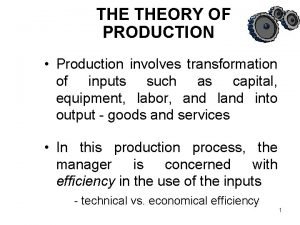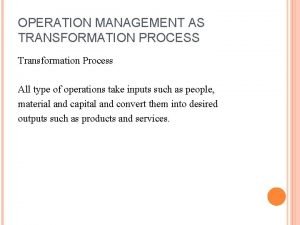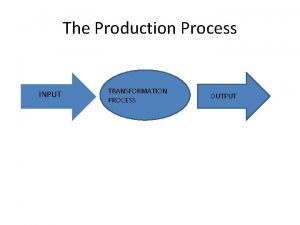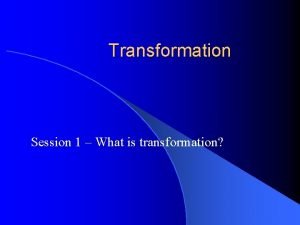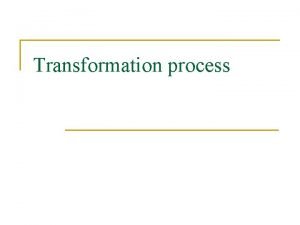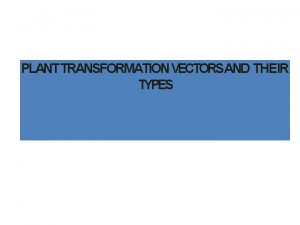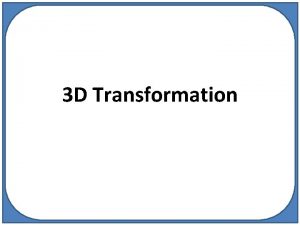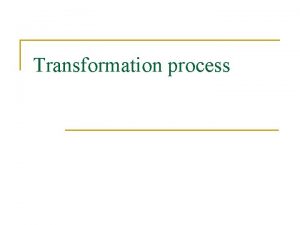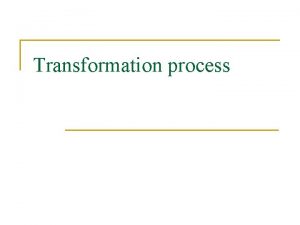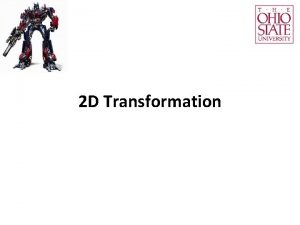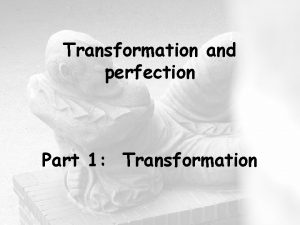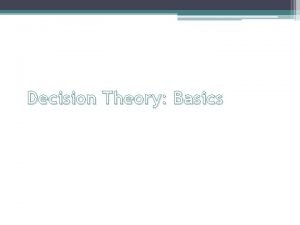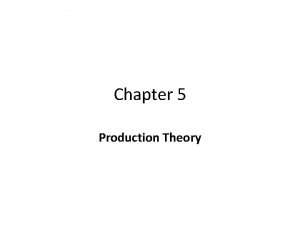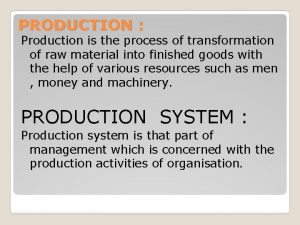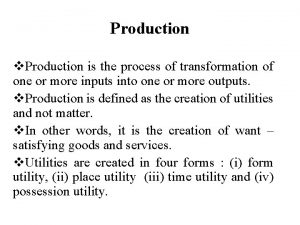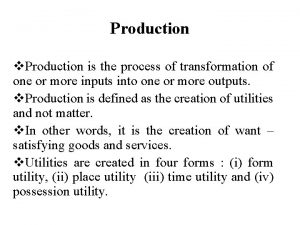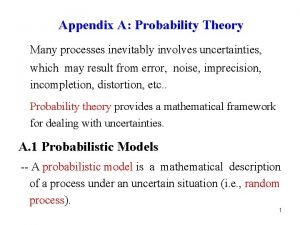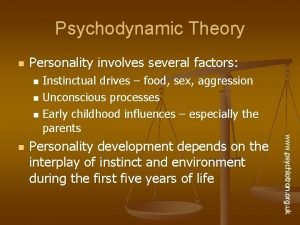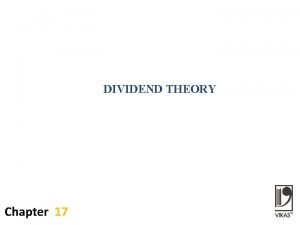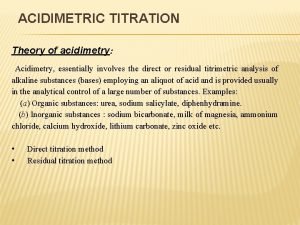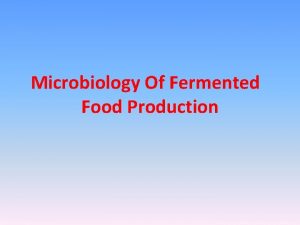THE THEORY OF PRODUCTION Production involves transformation of












































- Slides: 44

THE THEORY OF PRODUCTION • Production involves transformation of inputs such as capital, equipment, labor, and land into output - goods and services • In this production process, the manager is concerned with efficiency in the use of the inputs - technical vs. economical efficiency 1

Two Concepts of Efficiency • Economic efficiency: – occurs when the cost of producing a given output is as low as possible • Technological efficiency: – occurs when it is not possible to increase output without increasing inputs 2

You will see that basic production theory is simply an application of constrained optimization: the firm attempts either to minimize the cost of producing a given level of output or to maximize the output attainable with a given level of cost. Both optimization problems lead to same rule for the allocation of inputs and choice of technology 3

Production Function • A production function is purely technical relation which connects factor inputs & outputs. It describes the transformation of factor inputs into outputs at any particular time period. Q = f( L, K, R, Ld, T, t) where Q = output L= Labour K= Capital t = time R= Raw Material Ld = Land T = Technology For our current analysis, let’s reduce the inputs to two, capital (K) and labor (L): Q = f(L, K) 4

Production Table Same Q can be produced with different combinations of inputs, e. g. inputs are substitutable in some degree 5

Short-Run and Long-Run Production • In the short run some inputs are fixed and some variable – e. g. the firm may be able to vary the amount of labor, but cannot change the amount of capital – in the short run we can talk about factor productivity / law of variable proportion/law of diminishing returns 6

• In the long run all inputs become variable – e. g. the long run is the period in which a firm can adjust all inputs to changed conditions – in the long run we can talk about returns to scale 7

Short-Run Changes in Production Factor Productivity How much does the quantity of Q change, when the quantity of L is increased? 8

Long-Run Changes in Production Returns to Scale How much does the quantity of Q change, when the quantity of both L and K is increased? 9

Relationship Between Total, Average, and Marginal Product: Short-Run Analysis • Total Product (TP) = total quantity of output • Average Product (AP) = total product per total input • Marginal Product (MP) = change in quantity when one additional 10 unit of input used

The Marginal Product of Labor • The marginal product of labor is the increase in output obtained by adding 1 unit of labor but holding constant the inputs of all other factors Marginal Product of L: MPL= Q/ L (holding K constant) = Q/ L Average Product of L: APL= Q/L (holding K constant) 11

Law of Diminishing Returns (Diminishing Marginal Product) The law of diminishing returns states that when more and more units of a variable input are applied to a given quantity of fixed inputs, the total output may initially increase at an increasing rate and then at a constant rate but it will eventually increases at diminishing rates. Assumptions. The law of diminishing returns is based on the following assumptions: (i) the state of technology is given (ii) labour is homogenous and (iii) input prices are given. 12

Short-Run Analysis of Total, Average, and Marginal Product • If MP > AP then AP is rising • If MP < AP then AP is falling • MP = AP when AP is maximized • TP maximized when MP = 0 13

Three Stages of Production in Short Run AP, MP Stage III APX • TPL Increases at increasing rate. • MP Increases at decreasing rate. • AP is increasing and reaches its maximum at the end of stage I • TPL Increases at Diminshing rate. • MPL Begins to decline. • TP reaches maximum level at the end of stage II, MP = 0. • APL declines MPX • TPL begins to decline • MP becomes negative • AP continues to 14 decline X

15

Application of Law of Diminishing Returns: • It helps in identifying the rational and irrational stages of operations. • It gives answers to question – How much to produce? What number of workers to apply to a given fixed inputs so that the output is maximum? 16

Production in the Long -Run – All inputs are now considered to be variable (both L and K in our case) – How to determine the optimal combination of inputs? To illustrate this case we will use production isoquants. An isoquant is a locus of all technically efficient methods or all possible combinations of inputs for producing a given level of output. 17

Production Table Units of K Employed Isoquant 18

Isoquant 19

Types of Isoquant There exists some degree of substitutability between inputs. Different degrees of substitution: Natural flavoring Capital K 1 K 2 K 3 K 4 Sugar Cane syrup Q Sugar All other ingredients b) Input – Output/ La) Linear Isoquant Shaped Isoquant (Perfect substitution) complementarity) Q L 1 L 2 L 3 L 4 Labor c) Kinked/Acitivity Analysis Isoquant – 20 (Limited substitutability)

Marginal Rate of Technical Substitution MRTS • The degree of imperfection in substitutability is measured with marginal rate of technical substitution (MRTS- Slope of Isoquant): MRTS = L/ K (in this MRTS some of L is removed from the production and substituted by K to maintain the same level of output) 21

Properties of Isoquants • Isoquants have a negative slope. • Isoquants are convex to the origin. • Isoquants cannot intersect or be tangent to each other. • Upper Isoquants represents higher level of 22 output

Isoquant Map • Isoquant map is a set of isoquants presented on a two dimensional plain. Each isoquant shows various combinations of two inputs that can be used to produce a given level of output. 23

Laws of Returns to Scale • It explains the behavior of output in response to a proportional and simultaneous change in input. • When a firm increases both the inputs, there are three technical possibilities – (i) TP may increase more than proportionately – Increasing RTS (ii) TP may increase proportionately – constant RTS (iii) TP may increase less than proportionately – diminishing RTS 24

Increasing RTS K Product Line 3 K 3 X 2 K 2 X K X 0 L 2 L 3 L L 25

Constant RTS K Product Line 3 K 3 X 2 K 2 X K X 0 L 2 L 3 L L 26

Decreasing RTS K Product Line 3 K 3 X 2 K 2 X K X 0 L 2 L 3 L L 27

Elasticity of Factor Substitution • (� ) is formally defined as the percentage change in the capital labour ratios (K/L) divided by the percentage change in marginal rate of technical substitution (MRTS), i. e Percentage change in K/L (� )= Percentage change in MRTS д(K/L) / (K/L) (� )= д(MRTS) / (MRTS) 28

Cobb – Dougles function: - Production X= b 0 Lb 1 Kb 2 X= Out put L = qty of Labour K = qty of Capital bo , b 1 , b 2 Coefficient b 1 - Labour b 2 - Capital 29

Characteristics of Cobb – Dougles Prodn function: - 1. The Marginal Product of Factor: (a) MP L = dx/dl X = b 0 Lb 1 Kb 2 dx/dl = b 0 b 1 Lb 1 -1 Kb 2 = b 1 (bo. Lb 1 K b 2) L-1 = b 1 X/L = b 1 (AP L) APL Average Product of Labour Similarly (b) MP K = dx/dk = b 2 b 0 Lb 1 Kb 2 -1 = b 2 ( b 0 Lb 1 Kb 2) K-1 = b 2 X/K APk Average Product of Capital 30

2. The Marginal rate of technical substitution MRTS L. K = MPL MPK = dx/d. L = b 1(X/L) dx/dk b 2(X/K) MRTS LK = b 1 K b 2 L 31

3. The Elasticity of Substitution d k/L / k/l d. MRTS / MRTS = d. K/L/k/L b 1 dk b 1 k b 2 L EOS =1 This function is perfectly function. σ= substitutable 32

4. Factor intensity: - In cobb-Douglas function factor intensity is measured by ratio b 1/b 2. The higher is the ratio (b 1/b 2), the more labour intensive is the technique. Similarly, the lower the ratio (b 1/b 2) the more capital intensive is the technique. OR b 1/b 2 labour intensive b 1/b 2 capital intensive 33

5. Returns to scale: In cobb – Dougles production function RTS is measured by the sum of the coefficients b 1+b 2 = V x 0= f (L, K) X*= f(k. L, KK) A homogenous function is a function such that if each of the inputs is multiplied by K i. e ‘K’ can the completely factored out. ‘K’ also has a power V which is called the degree of homogeneity and it measures RTS. 34

X*= Kv f(x 0) X 0 = b 0 L b 1 K b 2 X* = b 0 (k. L) b 1 (k. K)b 2 = Kb 1+b 2 (bo L b 1 K b 2) =Kv f (X 0) (V=b 1 + b 2) X* = K v f (Xo) In case when V=1 we have constant RTS V>1 we have increasing RTS V<1 we have decreasing RTS 35

6. Efficiency of Production The efficiency in the organization of the factor of production is measured by the coefficient b 0 : If two firms have the same K, L, b 1, b 2 and still produce different quantities of output, the difference can be due to superior organization and entrepreneurship of one of the firms, which results in different effectiveness. The more efficient firm will have a larger b 0 than the less efficient one. b 0 More efficient is firm 36

Constant Elasticity Substitution (CES) Production Functions • The CES production function is expressed as 1. ‘A’ is the efficiency parameter and shows the scale effect. It indicates state of technology and entrepreneurial organizational aspects of production. Higher Value of A higher output (given same inputs) 37

2. �is the capital intensity factor coefficient and (1 - � ) is the labour intensity of coefficient. The value of �indicates the relative contribution of capital input and labour input to total output. 3. Value of Elasticity of Substitution (� ) depends upon the value of substitution parameter ‘β’ 4. The parameter v represents degree of returns to scale. 5. Marginal Products of labour and capital are always positive if we assume constant return to scale. 38

Equilibrium of the firm: Choice of optimal combination of factors of prodn • Assumptions: 1. The goal of the firm is profit maximization i. e maximization of difference ∏ - Profit R- Revenue C-Cost 2. The price of o/p is given, Px 3. The price of factors are given w is the given wage rate r is given price capital 39

Single Decision of the firm (a) Maximize profit ∏, subject to cost constraint. In this case total cost & prices are given and maximization of ∏ is if X is maximised since c & Px are given constant. ∏ = R-C = P x X-C (b) Maximise Profit ∏ for a given level of o/p. Maximisation of ∏ is achieved in this case if cost c is minimized , given that X & Px are given constants. ∏= R-C ∏= Px. X - C 40

We will use isoquant map (1) and isoquant line (2) The cost line is defined by cost equation C= (r) (k) + (w) (L) W wage rate r= price of capital service 41

Case I Maximization of output subject to cost constraint 42

Condition for Equilibrium • At point of tendency slope of isocost line (w/r ) = slope of isoquant. (MPL/MPK) • The isoquants should be convex to origin 43

Case II Minimization of cost for given level of output K e K 1 X 0 L 1 L 44
 Production function stages
Production function stages Alur proses produksi produk
Alur proses produksi produk Transformation process model of operations management
Transformation process model of operations management Input transformation output
Input transformation output Hát kết hợp bộ gõ cơ thể
Hát kết hợp bộ gõ cơ thể Frameset trong html5
Frameset trong html5 Bổ thể
Bổ thể Tỉ lệ cơ thể trẻ em
Tỉ lệ cơ thể trẻ em Voi kéo gỗ như thế nào
Voi kéo gỗ như thế nào Tư thế worms-breton
Tư thế worms-breton Chúa yêu trần thế alleluia
Chúa yêu trần thế alleluia Kể tên các môn thể thao
Kể tên các môn thể thao Thế nào là hệ số cao nhất
Thế nào là hệ số cao nhất Các châu lục và đại dương trên thế giới
Các châu lục và đại dương trên thế giới Công thức tiính động năng
Công thức tiính động năng Trời xanh đây là của chúng ta thể thơ
Trời xanh đây là của chúng ta thể thơ Mật thư tọa độ 5x5
Mật thư tọa độ 5x5 Phép trừ bù
Phép trừ bù độ dài liên kết
độ dài liên kết Các châu lục và đại dương trên thế giới
Các châu lục và đại dương trên thế giới Thể thơ truyền thống
Thể thơ truyền thống Quá trình desamine hóa có thể tạo ra
Quá trình desamine hóa có thể tạo ra Một số thể thơ truyền thống
Một số thể thơ truyền thống Cái miệng xinh xinh thế chỉ nói điều hay thôi
Cái miệng xinh xinh thế chỉ nói điều hay thôi Vẽ hình chiếu vuông góc của vật thể sau
Vẽ hình chiếu vuông góc của vật thể sau Biện pháp chống mỏi cơ
Biện pháp chống mỏi cơ đặc điểm cơ thể của người tối cổ
đặc điểm cơ thể của người tối cổ Ví dụ giọng cùng tên
Ví dụ giọng cùng tên Vẽ hình chiếu đứng bằng cạnh của vật thể
Vẽ hình chiếu đứng bằng cạnh của vật thể Fecboak
Fecboak Thẻ vin
Thẻ vin đại từ thay thế
đại từ thay thế điện thế nghỉ
điện thế nghỉ Tư thế ngồi viết
Tư thế ngồi viết Diễn thế sinh thái là
Diễn thế sinh thái là Các loại đột biến cấu trúc nhiễm sắc thể
Các loại đột biến cấu trúc nhiễm sắc thể Số nguyên tố là gì
Số nguyên tố là gì Tư thế ngồi viết
Tư thế ngồi viết Lời thề hippocrates
Lời thề hippocrates Thiếu nhi thế giới liên hoan
Thiếu nhi thế giới liên hoan ưu thế lai là gì
ưu thế lai là gì Khi nào hổ mẹ dạy hổ con săn mồi
Khi nào hổ mẹ dạy hổ con săn mồi Khi nào hổ mẹ dạy hổ con săn mồi
Khi nào hổ mẹ dạy hổ con săn mồi Hệ hô hấp
Hệ hô hấp Từ ngữ thể hiện lòng nhân hậu
Từ ngữ thể hiện lòng nhân hậu
